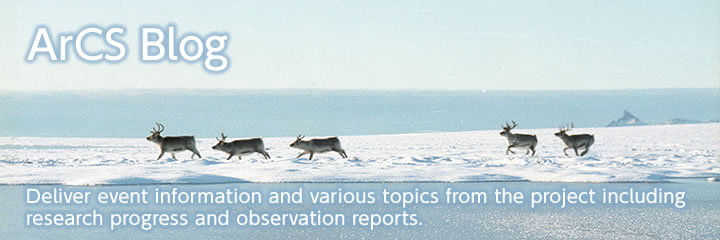I stayed at Adm Mickiewicz University in Poland from 18th September to 25th November 2019 to conduct a collaborative research on tardigrades collected from Japanese snow and an Alaskan glacier.

From February to November, 2019, we held the special mobile exhibition "Thawing Earth: Global Warming in Central Yakutia, Siberia" at 3 museums in Japan and at 2 venues in Sakha Republic, Russia. Based on the research results of the Tohoku University Group of ArCS Theme 7 (TG-ArCS7), and the collection of Hokkaido Museum of Northern Peoples (HMNP), this exhibition was produced by HMNP and the Center for Northeast Asian Studies, Tohoku University, and opened at HMNP first. Then with the cooperation and support of neighboring museums (Shiretoko Museum; SM and the Hokkaido University Museum; HUM), it toured them.
I participated in Ice Core Analysis Techniques (ICAT) PhD school-2019 and 8th International Ice Drill Symposium in Copenhagen, Denmark. Both are related to an ice core that I study. The Ice core is obtained by drilling the Greenland ice sheet, the Antarctic ice sheet, and glaciers. The information on the gas and chemical components in the ice core is useful for reconstructing the paleoclimate and paleoenvironment.
Greenland Science Week 2019 was held in Nuuk, the capital of Greenland during 1–5 December. This symposium aims to connect science with the Greenlandic society, and create a networking platform for the Greenlandic and international Arctic science communities. Residents of Greenland as well as international and Greenlandic researchers participated in this symposium. Five ArCS researchers participated in it to introduce activities of ArCS Research Theme 2 "Variations in the ice sheet, glaciers, ocean and environment in the Greenland region".
The Greenland Science Week was held in Nuuk, Greenland on 1−5 December in 2019. Next day, we visited Greenland Institute of Natural Resources (GINR). supports field works and research activities by Japanese scientists within Greenland. The Greenland Climate Research Centre (GCRC) at GINR shares a similar strategic goal with our project, which is the impact of climate changes on the marine ecosystem and Greenlandic society. To exchange ideas for future collaboration, we hold a seminar to introduce our field activities and to show study results conducted in northwestern Greenland.
Sakha and Japan scientists organized the exhibitions and launching of the book at Yakutsk (29 Nov) and Khaiakhsit village in Churapcha district (30 Nov).
The Arctic Greenland and Antarctic Ice Sheets are made of ice from the past snow. By drilling the ice sheet and analyzing the ice core (cylindrical ice), it is possible to reconstruct the global environment up to dozens of 10,000 years ago. From this year, I started research on ice core for polar ice sheets, focusing on the gas components contained in ice cores and the physical characteristics of snow and ice. Ice Core Analysis Techniques (ICAT) PhD school-2019 was held from September 23 to 28, 2019 in Copenhagen, Denmark, for the purpose of educating young ice core scientists. The International Ice Drill Symposium (IDS) was held from September 30th to October 3rd. I participated in ICAT and IDS with the aim of deepening my understanding of ice core research and solidifying the basis for future research.
Do you know about “Arctic Greening”? This describes the phenomenon that the tundra plants have been getting taller due to the climate change (especially temperature increase) and, as a result, the Arctic tundra has become greener than before. It is known that the degree of the greening is different across landscapes.
Kobe University Polar Cooperation Research Centre (PCRC) was established in 2015 to undertake Arctic international legal and policy studies under Theme 7 of ArCS project. PCRC will convene a special session at 12th Polar Law Symposium held in Hobart, Tasmania, 2-5 December 2019, to showcase the result of international collaborative research over the last 5 years and to consider the post-ArCS research agenda.
In the past month of July I had the opportunity to travel to Middleton island, Alaska, to conduct my research about plastic ingestion by seabirds. In collaboration with the Institute for Seabird Research and Conservation (ISRC), and sponsored by ArCS Program for Overseas Visits by Young Researchers, I had the possibility to conduct my experiment on Black-legged Kittiwakes, a seabird species that belongs to the gull family Laridae.




